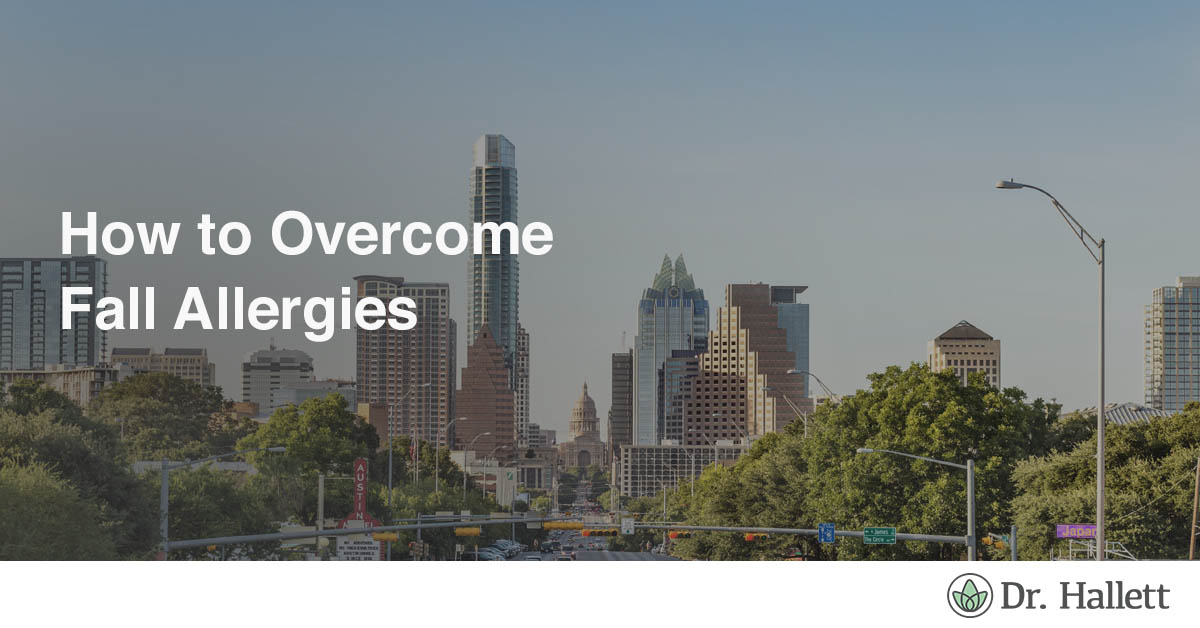
While fall can be an exciting time of year to be in Central Texas, many people encounter severe allergies that make being outdoors an unpleasant experience. For the 45 million Americans who suffer from seasonal allergies, fall can mean sneezing, itchy eyes and congestion. Beginning in mid-August and lasting all the way through October, the fall allergy season is now in full effect.
Ragweed, the heaviest pollinator in Central Texas during autumn, is one of the most common fall allergy triggers. Some studies have shown that up to 20 percent of Americans are allergic to ragweed. A single ragweed plant can release more than one billion grains of pollen in a season. And, while staying indoors can help, pollen can travel great distances — as much as 400 miles away from the plant — so it can be tricky to avoid ragweed pollen all together. Ragweed allergy symptoms can include sneezing, runny nose, stuffy nose, itchy nose and itchy, watery eyes.
Ragweed isn’t the only fall allergen about to peak. Cedar Elm trees and at least 10 other types of weeds also pollinate during the fall season, with weed pollen counts generally peaking around the beginning of October. And then there are the outdoor mold spores that are also released during this time of year.
People tend to think of indoor mold when it comes to mold allergies, but we may actually have more exposure to outdoor mold. In the autumn, mold spores can thrive in fallen leaves and other decaying vegetation. As mold particle counts climb higher, they become increasingly irritating to people with allergies. High mold counts also contribute to breathing problems among those with asthma.
Can you avoid allergies?
Without treatment, the best chance you might have for decreasing allergy symptoms is to avoid exposure. This may mean staying indoors with the windows closed as well as avoiding outdoor activities such as sports, camping and cookouts. Routine yard work can also stir pollen and mold spores into the air. If you’re raking leaves, mowing the lawn, working with mulch or trimming the shrubs, you may want to wear a mask, such as a NOISH N95.
Pollen counts are at their highest from 5 a.m. to 10 a.m. so staying indoors during those times can help reduce your exposure to the allergens and reduce your allergic symptoms. Changing your clothes after being outside can also help.
Unfortunately, attempting to escape allergies in the fall by remaining indoors may not completely do the trick. Low humidity inside homes can also be a major trigger of nasal and lung allergy irritation. Low humidity dries out the mucous membranes and leads to inflammation, while cold, dry air causes the lining of the nose to become swollen, resulting in a stuffy and runny nose.
Not to mention, it’s impossible to stay indoors all the time; which is why there are other ways to defend against fall allergens. Prescription-strength antihistamines and nasal steroids are now available over the counter. Antihistamines help reduce symptoms by blocking the histamines, or inflammatory chemicals, that cause them. Decongestants can also help reduce stuffiness. Lastly, eye drops can be added to your regimen to decrease itchy, watery eyes.
Allergy Drops can help build the body’s tolerance
When all your avoidance efforts and the over-the-counter medications don’t do the trick, then it’s time to call your allergist. A board-certified allergist can prescribe more intensive remedies to bring your current symptoms under control and develop a preventative plan using allergen immunotherapy that can help you avoid the misery of seasonal allergies in the future. Rather than reducing symptoms after they have started, allergen immunotherapy helps your body develop resistance to the pollen particles so that your symptoms are significantly reduced and much less severe. Oral allergy drops now offer a convenient, safe and effective option for patients who don’t want to be bothered with weekly allergy injections in the doctor’s office. An individualized extract prescription is prepared for each patient based on the results of allergy testing. Patients then take a daily dose of their drops and advance through build up dilutions to reach their maintenance dose in just one month. That makes now a great time to consider allergy drops as a way to fend off your fall allergies.
What’s Causing Your Symptoms?
The only way to truly tell what it is that’s affecting you is through allergy testing. Dr. Hallett offers a full range of allergy diagnostic testing to evaluate and manage allergies and asthma. He is the first — and most experienced — fellowship-trained, board-certified allergist in San Antonio to offer the more effective, high dose European protocol allergy drops. If you’d like to bring your fall allergies under control, come discover a treatment that is more satisfying than staying indoors or using over-the-counter drugs.